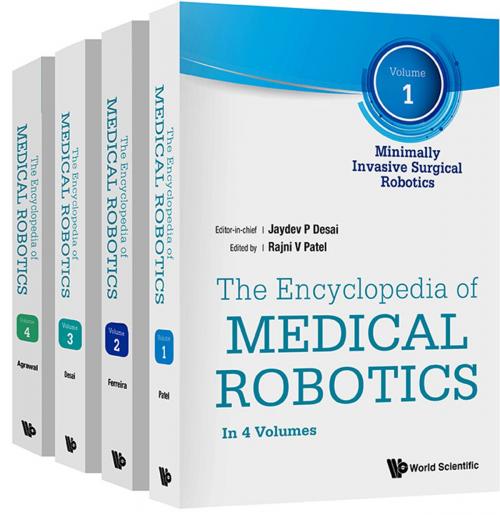The Encyclopedia of Medical Robotics
(In 4 Volumes)Volume 1: Minimally Invasive Surgical RoboticsVolume 2: Micro and Nano Robotics in MedicineVolume 3: Image-guided Surgical Procedures and InterventionsVolume 4: Rehabilitation Robotics
Nonfiction, Science & Nature, Technology, Robotics, Health & Well Being, Medical, Surgery| Author: | Jaydev P Desai, Rajni V Patel, Antoine Ferreira | ISBN: | 9789813232242 |
| Publisher: | World Scientific Publishing Company | Publication: | August 23, 2018 |
| Imprint: | WSPC | Language: | English |
| Author: | Jaydev P Desai, Rajni V Patel, Antoine Ferreira |
| ISBN: | 9789813232242 |
| Publisher: | World Scientific Publishing Company |
| Publication: | August 23, 2018 |
| Imprint: | WSPC |
| Language: | English |
The Encyclopedia of Medical Robotics combines contributions in four distinct areas of Medical robotics, namely: Minimally Invasive Surgical Robotics, Micro and Nano Robotics in Medicine, Image-guided Surgical Procedures and Interventions, and Rehabilitation Robotics. The volume on Minimally Invasive Surgical Robotics focuses on robotic technologies geared towards challenges and opportunities in minimally invasive surgery and the research, design, implementation and clinical use of minimally invasive robotic systems. The volume on Micro and Nano robotics in Medicine is dedicated to research activities in an area of emerging interdisciplinary technology that is raising new scientific challenges and promising revolutionary advancement in applications such as medicine and biology. The size and range of these systems are at or below the micrometer scale and comprise assemblies of micro and nanoscale components. The volume on Image-guided Surgical Procedures and Interventions focuses primarily on the use of image guidance during surgical procedures and the challenges posed by various imaging environments and how they related to the design and development of robotic systems as well as their clinical applications. This volume also has significant contributions from the clinical viewpoint on some of the challenges in the domain of image-guided interventions. Finally, the volume on Rehabilitation Robotics is dedicated to the state-of-the-art of an emerging interdisciplinary field where robotics, sensors, and feedback are used in novel ways to re-learn, improve, or restore functional movements in humans.
Volume 1, Minimally Invasive Surgical Robotics, focuses on an area of robotic applications that was established in the late 1990s, after the first robotics-assisted minimally invasive surgical procedure. This area has since received significant attention from industry and researchers. The teleoperated and ergonomic features of these robotic systems for minimally invasive surgery (MIS) have been able to reduce or eliminate most of the drawbacks of conventional (laparoscopic) MIS. Robotics-assisted MIS procedures have been conducted on over 3 million patients to date — primarily in the areas of urology, gynecology and general surgery using the FDA approved da Vinci® surgical system. The significant commercial and clinical success of the da Vinci® system has resulted in substantial research activity in recent years to reduce invasiveness, increase dexterity, provide additional features such as image guidance and haptic feedback, reduce size and cost, increase portability, and address specific clinical procedures. The area of robotic MIS is therefore in a state of rapid growth fueled by new developments in technologies such as continuum robotics, smart materials, sensing and actuation, and haptics and teleoperation. An important need arising from the incorporation of robotic technology for surgery is that of training in the appropriate use of the technology, and in the assessment of acquired skills. This volume covers the topics mentioned above in four sections. The first section gives an overview of the evolution and current state the da Vinci® system and clinical perspectives from three groups who use it on a regular basis. The second focuses on the research, and describes a number of new developments in surgical robotics that are likely to be the basis for the next generation of robotic MIS systems. The third deals with two important aspects of surgical robotic systems — teleoperation and haptics (the sense of touch). Technology for implementing the latter in a clinical setting is still very much at the research stage. The fourth section focuses on surgical training and skills assessment necessitated by the novelty and complexity of the technologies involved and the need to provide reliable and efficient training and objective assessment in the use of robotic MIS systems.
In Volume 2, Micro and Nano Robotics in Medicine, a brief historical overview of the field of medical nanorobotics as well as the state-of-the-art in the field is presented in the introductory chapter. It covers the various types of nanorobotic systems, their applications and future directions in this field. The volume is divided into three themes related to medical applications. The first theme describes the main challenges of microrobotic design for propulsion in vascular media. Such nanoscale robotic agents are envisioned to revolutionize medicine by enabling minimally invasive diagnostic and therapeutic procedures. To be useful, nanorobots must be operated in complex biological fluids and tissues, which are often difficult to penetrate. In this section, a collection of four papers review the potential medical applications of motile nanorobots, catalytic-based propelling agents, biologically-inspired microrobots and nanoscale bacteria-enabled autonomous drug delivery systems. The second theme relates to the use of micro and nanorobots inside the body for drug-delivery and surgical applications. A collection of six chapters is presented in this segment. The first chapter reviews the different robot structures for three different types of surgery, namely laparoscopy, catheterization, and ophthalmic surgery. It highlights the progress of surgical microrobotics toward intracorporeally navigated mechanisms for ultra-minimally invasive interventions. Then, the design of different magnetic actuation platforms used in micro and nanorobotics are described. An overview of magnetic actuation-based control methods for microrobots, with eventually biomedical applications, is also covered in this segment. The third theme discusses the various nanomanipulation strategies that are currently used in biomedicine for cell characterization, injection, fusion and engineering. In-vitro (3D) cell culture has received increasing attention since it has been discovered to provide a better simulation environment of in-vivo cell growth. Nowadays, the rapid progress of robotic technology paves a new path for the highly controllable and flexible 3D cell assembly. One chapter in this segment discusses the applications of micro-nano robotic techniques for 3D cell culture using engineering approaches. Because cell fusion is important in numerous biological events and applications, such as tissue regeneration and cell reprogramming, a chapter on robotic-tweezers cell manipulation system to achieve precise laser-induced cell fusion using optical trapping has been included in this volume. Finally, the segment ends with a chapter on the use of novel MEMS-based characterization of micro-scale tissues instead of mechanical characterization for cell lines studies.
Volume 3, Image-guided Surgical Procedures and Interventions, focuses on several aspects ranging from understanding the challenges and opportunities in this domain, to imaging technologies, to image-guided robotic systems for clinical applications. The volume includes several contributions in the area of imaging in the areas of X-Ray fluoroscopy, CT, PET, MR Imaging, Ultrasound imaging, and optical coherence tomography. Ultrasound-based diagnostics and therapeutics as well as ultrasound-guided planning and navigation are also included in this volume in addition to multi-modal imaging techniques and its applications to surgery and various interventions. The application of multi-modal imaging and fusion in the area of prostate biopsy is also covered. Imaging modality compatible robotic systems, sensors and actuator technologies for use in the MRI environment are also included in this work., as is the development of the framework incorporating image-guided modeling for surgery and intervention. Finally, there are several chapters in the clinical applications domain covering cochlear implant surgery, neurosurgery, breast biopsy, prostate cancer treatment, endovascular interventions, neurovascular interventions, robotic capsule endoscopy, and MRI-guided neurosurgical procedures and interventions.
Volume 4, Rehabilitation Robotics, is dedicated to the state-of-the-art of an emerging interdisciplinary field where robotics, sensors, and feedback are used in novel ways to relearn, improve, or restore functional movements in humans. This volume attempts to cover a number of topics relevant to the field. The first section addresses an important activity in our daily lives: walking, where the neuromuscular system orchestrates the gait, posture, and balance. Conditions such as stroke, vestibular deficits, or old age impair this important activity. Three chapters on robotic training, gait rehabilitation, and cooperative orthoses describe the current works in the field to address this issue. The second section covers the significant advances in and novel designs of soft actuators and wearable systems that have emerged in the area of prosthetic lower limbs and ankles in recent years, which offer potential for both rehabilitation and human augmentation. These are described in two chapters. The next section addresses an important emphasis in the field of medicine today that strives to bring rehabilitation out from the clinic into the home environment, so that these medical aids are more readily available to users. The current state-of-the-art in this field is described in a chapter. The last section focuses on rehab devices for the pediatric population. Their impairments are life-long and rehabilitation robotics can have an even bigger impact during their lifespan. In recent years, a number of new developments have been made to promote mobility, socialization, and rehabilitation among the very young: the infants and toddlers. These aspects are summarized in two chapters of this volume.
Contents:
-
Volume 1: Minimally Invasive Surgical Robotics (Rajni V Patel):
-
The da Vinci® Surgical System and Clinical Perspectives:
- The da Vinci Surgical System (Mahdi Azizian, May Liu, Iman Khalaji, and Simon DiMaio)
- A Clinical Perspective on the Application of Surgical Robotics for Radical Prostatectomy (Melissa J Huynh and Stephen E Pautler)
- Robot-assisted Coronary and Mitral Valve Surgery (Bob Kiaii and Michael W A Chu)
- Minimally Invasive Robotic Gastrointestinal Surgery (Mooyad A Ahmed, Nawar A Alkhamesi, Khalid Alsowaina, and Christopher Schalchta)
-
New Developments and Challenges in Surgical Robotic Systems:
- The DLR MiroSurge Surgical Robotic Demonstrator (Ulrich Seibold, Bernhard Kübler, Thomas Bahls, Robert Haslinger, and Florian Steidle)
- Single-Port Access Robots for MIS (Jianzhong Shang, Valentina Vitiello, and Guang-Zhong Yang)
- A Review of Concentric Tube Robots: Modeling, Control, Design, Planning, and Sensing (Arthur W Mahoney, Hunter B Gilbert, and Robert J Webster III)
- Snake-like Robots for Minimally Invasive, Single-Port, and Intraluminal Surgeries (Andrew L Orekhov, Colette Abah and Nabil Simaan)
- Flexible Meso-scale Robots for Surgery (Yeongjin Kim, Shing Shin Cheng, Jun Sheng, and Jaydev P Desai)
- Robot Autonomy for Surgery (Michael Yip and Nikhil Das)
-
Haptics and Teleoperation:
- Haptics in Robot-assisted Minimally Invasive Surgery (Allison M Okamura)
- Teleoperation for Minimally Invasive Robotics-assisted Surgery (Seyed Farokh Atashzar and Rajni V Patel)
-
Training and Skill Assessment:
- Training and Skill Assessment for Robotic-assisted Minimally Invasive Surgery — Part 1: Historical Perspective and Challenges (Suren Kumar, Javad Sovizi, and Venkat N Krovi)
- Training and Skill Assessment for Robotics-assisted Minimally Invasive Surgery — Part 2: State-of-the-Art, Techniques and Technologies (Ana Luisa Trejos, Mahya Shahbazi and Rajni V Patel)
-
-
Volume 2: Micro and Nano Robotics in Medicine (Antoine Ferreira):
-
Introduction: Medical Micro- and Nanorobotics (Sylvain Martel)
-
Microrobotics for Propulsion in Vascular Media:
- Nanoscale Robotic Agents in Biological Fluids and Tissues (Stefano Palagi, Debora Walker, Tian Qiu, and Peer Fisher)
- Catalytic-based Propelling Agents for Biomedical Applications (Maria Guix and Oliver Schmidt)
- Biologically Inspired Microrobotics (Islam S M Khalil and Shartak Misra)
- Nanoscale Bacteria-enabled Autonomous Delivery Systems (NanoBEADS) for Cancer Therapy (Eric J Leaman, SeungBeum Suh, and Bahareh Behkam)
-
Inside the Body Nanorobotic Applications:
- Electromagnetic Actuated Micro- and Nanorobots (Hyunchul Choi, Jong-Oh Park, and Sukho Park)
- Magnetic Resonance Navigation for Microrobotic Drug Delivery (Alexandre Bigot)
- Toward Intracorporeally Navigated Untethered Microsurgeons (Christos Bergeles)
- Motion Control of Magnetic Microrobots for Nanomedicine (Tiantian Xu, Antoine Ferreira, Hongsoo Choi, and Li Zhang)
- Modeling Approach of Transcatheter Arterial Delivery of Drug-Loaded Magnetic Nanoparticles (Lyès Mellal, David Folio, Karim Belharet, and Antoine Ferreira)
-
Nanomanipulation in Biomedical Applications:
- Laser-induced Cell Fusion by Robot-Tweezers Manipulation (Shuxun Chen, Wang Ran, and Dong Sun)
- 3D System Cell Engineering Using Micro-Nanorobotics (Toshio Fukuda, Masaru Nakajima, Masaru Takeuchi, Yasuhisa Hasegawa, Tao Yue, Chengzhi Hu, Mohd Ridzuan Ahmad, and Yajing Shen)
- Microscale Sensors for Breast Cancer Diagnosis (Hardik J Pandya, Rajarshi Roy, Kihan Park, and Jaydev P Desai)
-
-
Volume 3: Image-guided Surgical Procedures and Interventions (Jaydev P Desai):
- Image-guided Surgical Procedures and Interventions: Challenges and Opportunities (Terry Peters)
- X-Ray Fluoroscopy, CT, PET, and MR Imaging (Guang Li, Prashant Raghavan, Rao P Gullapalli, and Jiachen Zhuo)
- Ultrasound: Diagnostics and Therapeutics (Meaghan A O'Reilly)
- Optical Coherence Tomography (OCT) (Zhifang Li, Qinggong Tang, Bohan Wang, and Yu Chen)
- Multi-modal Imaging for Surgery and Interventions (W Gao, B Jiang, T Kapur, and J Jayender)
- Ultrasound-guided Planning and Navigation (Septimiu Salcudean)
- Multi-modality Imaging (MRI, PET, and Ultrasound) and Fusion Targeted Biopsy of the Prostate (Baowei Fei)
- Sensors, Actuators, and Robots for MRI-guided Surgery and Interventions (Hao Su, Gang Li, and Gregory S Fischer)
- Image-guided Procedures in Surgery and Intervention: Challenges in Image-to-Physical Registration and Beyond (Michael I Miga, Logan W Clements, and Jared A Weis)
- Image-guided Robotic Cochlear Implant Surgery (Tom Williamson, Wilhelm Wimmer, Kate Gavaghan, Nicolas Gerber, Xinli Du, Peter Brett, Chris Coulson, David Proops, Marco Caversaccio, and Stefan Weber)
- Meso-scale Robotic Systems for Neurosurgery (Jun Sheng, Shing Shin Cheng, Yeongjin Kim, and Jaydev P Desai)
- Image-guided Robotic Neurosurgery (Jesse A Stokum, David B Kurland, Philip Smith, and J Marc Simard)
- MRI-guided Robotic Breast Biopsy and Therapeutics (Nikolaos V Tsekos and Eftychios G Christoforou)
- Image-guided Robotic Interventions for Prostate Cancer Treatment (Tarun K Podder, Karin Hermann, and Rodney J Ellis)
- Image-guided Endovascular Interventions (Su-Lin Lee)
- Image-guided Neurovascular Interventions (Yafell Serulle and Dheeraj Gandhi)
- Robotic Capsule Endoscopy (Piotr R Slawinski, Addisu Z Taddese, Keith L Obstein, and Pietro Valdastri)
- Image-guided Neurosurgical Procedures and Interventions (Vivek Buch, Kerry Vaughn, and Timothy Lucas)
-
Volume 4: Rehabilitation Robotics (Sunil Agrawal):
- Robot-aided Gait Training (Robert Riener)
- Research and Development Trends of Robot-assisted Walking Rehabilitation Incorporating Postural Balancing (K H Low and Lei Li)
- A Cooperative Robotic Orthosis for Gait Assistance (Andrea Parri, Tingfang Yan, Francesco Giovacchini, Mario Cortese, Marco Muscolo, Matteo Fantozzi, Guido Pasquini, Federica Vannetti, Raffaele Molino Lova and Nicola Vitiello)
- User-adaptive Control of Robotic Lower Limb Prostheses (Tomasso Lenzi and Levi Hargrove)
- Ankle Prosthetics and Orthotics: Trends from Passive to Active Systems (Thomas G Sugar, Jeffrey A Ward, and Martin Grimmer)
- Soft Robotic Glove for Combined Assistance and Rehabilitation During Activities of Daily Living (Kevin C Galloway, Panagiotis Polygerinos, Robert J Wood, and Conor J Walsh)
- Rehabilitation Robotics: Wearable Systems (Changsoo Han)
- A Review of Home-based Robotic Rehabilitation (Aliakbar Alamdari, Seungkook Jun, Daniel Ramsey, and Venkat Krovi)
- Robot-enhanced Walkers for Training of Children with Cerebral Palsy: Pilot Studies (Jiyeon Kang and Sunil Kumar Agrawal)
- From Autism Spectrum Disorder to Cerebral Palsy: State of the Art in Pediatric Therapy Robots (Ayanna Howard, Yu-Ping Chen, and Chung Hyuk Park)
Readership: Researchers, graduates, and post-graduate students active in the field of bioengineering and robotics.
0
The Encyclopedia of Medical Robotics combines contributions in four distinct areas of Medical robotics, namely: Minimally Invasive Surgical Robotics, Micro and Nano Robotics in Medicine, Image-guided Surgical Procedures and Interventions, and Rehabilitation Robotics. The volume on Minimally Invasive Surgical Robotics focuses on robotic technologies geared towards challenges and opportunities in minimally invasive surgery and the research, design, implementation and clinical use of minimally invasive robotic systems. The volume on Micro and Nano robotics in Medicine is dedicated to research activities in an area of emerging interdisciplinary technology that is raising new scientific challenges and promising revolutionary advancement in applications such as medicine and biology. The size and range of these systems are at or below the micrometer scale and comprise assemblies of micro and nanoscale components. The volume on Image-guided Surgical Procedures and Interventions focuses primarily on the use of image guidance during surgical procedures and the challenges posed by various imaging environments and how they related to the design and development of robotic systems as well as their clinical applications. This volume also has significant contributions from the clinical viewpoint on some of the challenges in the domain of image-guided interventions. Finally, the volume on Rehabilitation Robotics is dedicated to the state-of-the-art of an emerging interdisciplinary field where robotics, sensors, and feedback are used in novel ways to re-learn, improve, or restore functional movements in humans.
Volume 1, Minimally Invasive Surgical Robotics, focuses on an area of robotic applications that was established in the late 1990s, after the first robotics-assisted minimally invasive surgical procedure. This area has since received significant attention from industry and researchers. The teleoperated and ergonomic features of these robotic systems for minimally invasive surgery (MIS) have been able to reduce or eliminate most of the drawbacks of conventional (laparoscopic) MIS. Robotics-assisted MIS procedures have been conducted on over 3 million patients to date — primarily in the areas of urology, gynecology and general surgery using the FDA approved da Vinci® surgical system. The significant commercial and clinical success of the da Vinci® system has resulted in substantial research activity in recent years to reduce invasiveness, increase dexterity, provide additional features such as image guidance and haptic feedback, reduce size and cost, increase portability, and address specific clinical procedures. The area of robotic MIS is therefore in a state of rapid growth fueled by new developments in technologies such as continuum robotics, smart materials, sensing and actuation, and haptics and teleoperation. An important need arising from the incorporation of robotic technology for surgery is that of training in the appropriate use of the technology, and in the assessment of acquired skills. This volume covers the topics mentioned above in four sections. The first section gives an overview of the evolution and current state the da Vinci® system and clinical perspectives from three groups who use it on a regular basis. The second focuses on the research, and describes a number of new developments in surgical robotics that are likely to be the basis for the next generation of robotic MIS systems. The third deals with two important aspects of surgical robotic systems — teleoperation and haptics (the sense of touch). Technology for implementing the latter in a clinical setting is still very much at the research stage. The fourth section focuses on surgical training and skills assessment necessitated by the novelty and complexity of the technologies involved and the need to provide reliable and efficient training and objective assessment in the use of robotic MIS systems.
In Volume 2, Micro and Nano Robotics in Medicine, a brief historical overview of the field of medical nanorobotics as well as the state-of-the-art in the field is presented in the introductory chapter. It covers the various types of nanorobotic systems, their applications and future directions in this field. The volume is divided into three themes related to medical applications. The first theme describes the main challenges of microrobotic design for propulsion in vascular media. Such nanoscale robotic agents are envisioned to revolutionize medicine by enabling minimally invasive diagnostic and therapeutic procedures. To be useful, nanorobots must be operated in complex biological fluids and tissues, which are often difficult to penetrate. In this section, a collection of four papers review the potential medical applications of motile nanorobots, catalytic-based propelling agents, biologically-inspired microrobots and nanoscale bacteria-enabled autonomous drug delivery systems. The second theme relates to the use of micro and nanorobots inside the body for drug-delivery and surgical applications. A collection of six chapters is presented in this segment. The first chapter reviews the different robot structures for three different types of surgery, namely laparoscopy, catheterization, and ophthalmic surgery. It highlights the progress of surgical microrobotics toward intracorporeally navigated mechanisms for ultra-minimally invasive interventions. Then, the design of different magnetic actuation platforms used in micro and nanorobotics are described. An overview of magnetic actuation-based control methods for microrobots, with eventually biomedical applications, is also covered in this segment. The third theme discusses the various nanomanipulation strategies that are currently used in biomedicine for cell characterization, injection, fusion and engineering. In-vitro (3D) cell culture has received increasing attention since it has been discovered to provide a better simulation environment of in-vivo cell growth. Nowadays, the rapid progress of robotic technology paves a new path for the highly controllable and flexible 3D cell assembly. One chapter in this segment discusses the applications of micro-nano robotic techniques for 3D cell culture using engineering approaches. Because cell fusion is important in numerous biological events and applications, such as tissue regeneration and cell reprogramming, a chapter on robotic-tweezers cell manipulation system to achieve precise laser-induced cell fusion using optical trapping has been included in this volume. Finally, the segment ends with a chapter on the use of novel MEMS-based characterization of micro-scale tissues instead of mechanical characterization for cell lines studies.
Volume 3, Image-guided Surgical Procedures and Interventions, focuses on several aspects ranging from understanding the challenges and opportunities in this domain, to imaging technologies, to image-guided robotic systems for clinical applications. The volume includes several contributions in the area of imaging in the areas of X-Ray fluoroscopy, CT, PET, MR Imaging, Ultrasound imaging, and optical coherence tomography. Ultrasound-based diagnostics and therapeutics as well as ultrasound-guided planning and navigation are also included in this volume in addition to multi-modal imaging techniques and its applications to surgery and various interventions. The application of multi-modal imaging and fusion in the area of prostate biopsy is also covered. Imaging modality compatible robotic systems, sensors and actuator technologies for use in the MRI environment are also included in this work., as is the development of the framework incorporating image-guided modeling for surgery and intervention. Finally, there are several chapters in the clinical applications domain covering cochlear implant surgery, neurosurgery, breast biopsy, prostate cancer treatment, endovascular interventions, neurovascular interventions, robotic capsule endoscopy, and MRI-guided neurosurgical procedures and interventions.
Volume 4, Rehabilitation Robotics, is dedicated to the state-of-the-art of an emerging interdisciplinary field where robotics, sensors, and feedback are used in novel ways to relearn, improve, or restore functional movements in humans. This volume attempts to cover a number of topics relevant to the field. The first section addresses an important activity in our daily lives: walking, where the neuromuscular system orchestrates the gait, posture, and balance. Conditions such as stroke, vestibular deficits, or old age impair this important activity. Three chapters on robotic training, gait rehabilitation, and cooperative orthoses describe the current works in the field to address this issue. The second section covers the significant advances in and novel designs of soft actuators and wearable systems that have emerged in the area of prosthetic lower limbs and ankles in recent years, which offer potential for both rehabilitation and human augmentation. These are described in two chapters. The next section addresses an important emphasis in the field of medicine today that strives to bring rehabilitation out from the clinic into the home environment, so that these medical aids are more readily available to users. The current state-of-the-art in this field is described in a chapter. The last section focuses on rehab devices for the pediatric population. Their impairments are life-long and rehabilitation robotics can have an even bigger impact during their lifespan. In recent years, a number of new developments have been made to promote mobility, socialization, and rehabilitation among the very young: the infants and toddlers. These aspects are summarized in two chapters of this volume.
Contents:
-
Volume 1: Minimally Invasive Surgical Robotics (Rajni V Patel):
-
The da Vinci® Surgical System and Clinical Perspectives:
- The da Vinci Surgical System (Mahdi Azizian, May Liu, Iman Khalaji, and Simon DiMaio)
- A Clinical Perspective on the Application of Surgical Robotics for Radical Prostatectomy (Melissa J Huynh and Stephen E Pautler)
- Robot-assisted Coronary and Mitral Valve Surgery (Bob Kiaii and Michael W A Chu)
- Minimally Invasive Robotic Gastrointestinal Surgery (Mooyad A Ahmed, Nawar A Alkhamesi, Khalid Alsowaina, and Christopher Schalchta)
-
New Developments and Challenges in Surgical Robotic Systems:
- The DLR MiroSurge Surgical Robotic Demonstrator (Ulrich Seibold, Bernhard Kübler, Thomas Bahls, Robert Haslinger, and Florian Steidle)
- Single-Port Access Robots for MIS (Jianzhong Shang, Valentina Vitiello, and Guang-Zhong Yang)
- A Review of Concentric Tube Robots: Modeling, Control, Design, Planning, and Sensing (Arthur W Mahoney, Hunter B Gilbert, and Robert J Webster III)
- Snake-like Robots for Minimally Invasive, Single-Port, and Intraluminal Surgeries (Andrew L Orekhov, Colette Abah and Nabil Simaan)
- Flexible Meso-scale Robots for Surgery (Yeongjin Kim, Shing Shin Cheng, Jun Sheng, and Jaydev P Desai)
- Robot Autonomy for Surgery (Michael Yip and Nikhil Das)
-
Haptics and Teleoperation:
- Haptics in Robot-assisted Minimally Invasive Surgery (Allison M Okamura)
- Teleoperation for Minimally Invasive Robotics-assisted Surgery (Seyed Farokh Atashzar and Rajni V Patel)
-
Training and Skill Assessment:
- Training and Skill Assessment for Robotic-assisted Minimally Invasive Surgery — Part 1: Historical Perspective and Challenges (Suren Kumar, Javad Sovizi, and Venkat N Krovi)
- Training and Skill Assessment for Robotics-assisted Minimally Invasive Surgery — Part 2: State-of-the-Art, Techniques and Technologies (Ana Luisa Trejos, Mahya Shahbazi and Rajni V Patel)
-
-
Volume 2: Micro and Nano Robotics in Medicine (Antoine Ferreira):
-
Introduction: Medical Micro- and Nanorobotics (Sylvain Martel)
-
Microrobotics for Propulsion in Vascular Media:
- Nanoscale Robotic Agents in Biological Fluids and Tissues (Stefano Palagi, Debora Walker, Tian Qiu, and Peer Fisher)
- Catalytic-based Propelling Agents for Biomedical Applications (Maria Guix and Oliver Schmidt)
- Biologically Inspired Microrobotics (Islam S M Khalil and Shartak Misra)
- Nanoscale Bacteria-enabled Autonomous Delivery Systems (NanoBEADS) for Cancer Therapy (Eric J Leaman, SeungBeum Suh, and Bahareh Behkam)
-
Inside the Body Nanorobotic Applications:
- Electromagnetic Actuated Micro- and Nanorobots (Hyunchul Choi, Jong-Oh Park, and Sukho Park)
- Magnetic Resonance Navigation for Microrobotic Drug Delivery (Alexandre Bigot)
- Toward Intracorporeally Navigated Untethered Microsurgeons (Christos Bergeles)
- Motion Control of Magnetic Microrobots for Nanomedicine (Tiantian Xu, Antoine Ferreira, Hongsoo Choi, and Li Zhang)
- Modeling Approach of Transcatheter Arterial Delivery of Drug-Loaded Magnetic Nanoparticles (Lyès Mellal, David Folio, Karim Belharet, and Antoine Ferreira)
-
Nanomanipulation in Biomedical Applications:
- Laser-induced Cell Fusion by Robot-Tweezers Manipulation (Shuxun Chen, Wang Ran, and Dong Sun)
- 3D System Cell Engineering Using Micro-Nanorobotics (Toshio Fukuda, Masaru Nakajima, Masaru Takeuchi, Yasuhisa Hasegawa, Tao Yue, Chengzhi Hu, Mohd Ridzuan Ahmad, and Yajing Shen)
- Microscale Sensors for Breast Cancer Diagnosis (Hardik J Pandya, Rajarshi Roy, Kihan Park, and Jaydev P Desai)
-
-
Volume 3: Image-guided Surgical Procedures and Interventions (Jaydev P Desai):
- Image-guided Surgical Procedures and Interventions: Challenges and Opportunities (Terry Peters)
- X-Ray Fluoroscopy, CT, PET, and MR Imaging (Guang Li, Prashant Raghavan, Rao P Gullapalli, and Jiachen Zhuo)
- Ultrasound: Diagnostics and Therapeutics (Meaghan A O'Reilly)
- Optical Coherence Tomography (OCT) (Zhifang Li, Qinggong Tang, Bohan Wang, and Yu Chen)
- Multi-modal Imaging for Surgery and Interventions (W Gao, B Jiang, T Kapur, and J Jayender)
- Ultrasound-guided Planning and Navigation (Septimiu Salcudean)
- Multi-modality Imaging (MRI, PET, and Ultrasound) and Fusion Targeted Biopsy of the Prostate (Baowei Fei)
- Sensors, Actuators, and Robots for MRI-guided Surgery and Interventions (Hao Su, Gang Li, and Gregory S Fischer)
- Image-guided Procedures in Surgery and Intervention: Challenges in Image-to-Physical Registration and Beyond (Michael I Miga, Logan W Clements, and Jared A Weis)
- Image-guided Robotic Cochlear Implant Surgery (Tom Williamson, Wilhelm Wimmer, Kate Gavaghan, Nicolas Gerber, Xinli Du, Peter Brett, Chris Coulson, David Proops, Marco Caversaccio, and Stefan Weber)
- Meso-scale Robotic Systems for Neurosurgery (Jun Sheng, Shing Shin Cheng, Yeongjin Kim, and Jaydev P Desai)
- Image-guided Robotic Neurosurgery (Jesse A Stokum, David B Kurland, Philip Smith, and J Marc Simard)
- MRI-guided Robotic Breast Biopsy and Therapeutics (Nikolaos V Tsekos and Eftychios G Christoforou)
- Image-guided Robotic Interventions for Prostate Cancer Treatment (Tarun K Podder, Karin Hermann, and Rodney J Ellis)
- Image-guided Endovascular Interventions (Su-Lin Lee)
- Image-guided Neurovascular Interventions (Yafell Serulle and Dheeraj Gandhi)
- Robotic Capsule Endoscopy (Piotr R Slawinski, Addisu Z Taddese, Keith L Obstein, and Pietro Valdastri)
- Image-guided Neurosurgical Procedures and Interventions (Vivek Buch, Kerry Vaughn, and Timothy Lucas)
-
Volume 4: Rehabilitation Robotics (Sunil Agrawal):
- Robot-aided Gait Training (Robert Riener)
- Research and Development Trends of Robot-assisted Walking Rehabilitation Incorporating Postural Balancing (K H Low and Lei Li)
- A Cooperative Robotic Orthosis for Gait Assistance (Andrea Parri, Tingfang Yan, Francesco Giovacchini, Mario Cortese, Marco Muscolo, Matteo Fantozzi, Guido Pasquini, Federica Vannetti, Raffaele Molino Lova and Nicola Vitiello)
- User-adaptive Control of Robotic Lower Limb Prostheses (Tomasso Lenzi and Levi Hargrove)
- Ankle Prosthetics and Orthotics: Trends from Passive to Active Systems (Thomas G Sugar, Jeffrey A Ward, and Martin Grimmer)
- Soft Robotic Glove for Combined Assistance and Rehabilitation During Activities of Daily Living (Kevin C Galloway, Panagiotis Polygerinos, Robert J Wood, and Conor J Walsh)
- Rehabilitation Robotics: Wearable Systems (Changsoo Han)
- A Review of Home-based Robotic Rehabilitation (Aliakbar Alamdari, Seungkook Jun, Daniel Ramsey, and Venkat Krovi)
- Robot-enhanced Walkers for Training of Children with Cerebral Palsy: Pilot Studies (Jiyeon Kang and Sunil Kumar Agrawal)
- From Autism Spectrum Disorder to Cerebral Palsy: State of the Art in Pediatric Therapy Robots (Ayanna Howard, Yu-Ping Chen, and Chung Hyuk Park)
Readership: Researchers, graduates, and post-graduate students active in the field of bioengineering and robotics.
0















